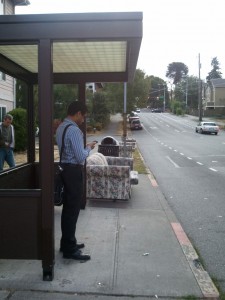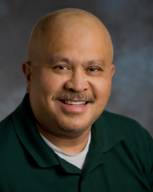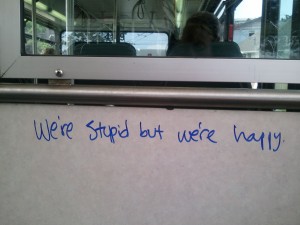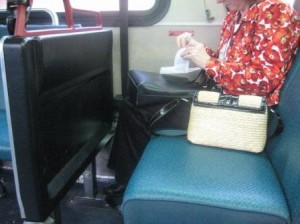If Metro insists on removing our shelter benches…
27 + 55 = Mom
Today would have been my mother‘s 66th birthday. Bus Nerd is out of town, but Chicklet, Busling, and I made the pilgrimage to the church where her ashes are buried. (This was the first year we brought home-grown flowers: some Cosmos something-or-others Chicklet and I planted in the spring.) We spent the better part of the day in the neighborhood–lunching with my brother, playing at a nearby park, and–mostly–thinking about how much we miss having her in our lives.
In honor of my amazing mama, I’m reposting my February, 2007, Real Change column:
On Jan. 3, after a four-and-a-half year battle with breast cancer, my mother, Caroline Dunne Saulter, died. She was 61 years old.
Caroline never approved of my choice to live without a car. She blamed herself, for allowing me to ride the bus at such an early age; my father, for showing me how; my husband, for providing my first example of car-freedom; and me, for being my stubborn, willful (and impractical) self. She wanted me to live a mainstream middle-class life, to stay indefinitely when I visited (instead of until the last bus left her neighborhood), to be protected from the elements, and to be inside (either a building or a vehicle) after dark. Despite my unwavering commitment to my choice, she hoped that one day I would grow up, get over it, and just buy a hybrid already.
The irony of this is that it was, in large part, my mother’s example that gave me the courage to step outside the mainstream and choose a life that reflected my values.
Caroline’s commitment to her own ideals began at an early age. Despite her head-turning beauty and easy popularity, she chose not to accept the bigoted views of her peers in the suburban Ohio town where she attended high school and almost always found herself on the “wrong” side of lunch-table arguments. When she was 16, she took a bus by herself from Cleveland to Washington, D.C., to participate in the March on Washington. She remembered the experience as one of the most moving of her life.
In 1966, she left college, joined Volunteers in Service to America (VISTA), and moved to Oregon to help improve conditions for Russian and Mexican migrant workers. It was there that she met my father, a Seattle native and brilliant University of Oregon architecture student who also happened to be Black. They married — at a time when many states still had anti-miscegenation laws — and finished school together.
When Caroline was 28 and most of her girlfriends were shopping preschools, she and my father joined the Peace Corps and moved (along with my older sister, Carey, and me) to Morocco for two years. After we returned, she continued to give her time to the causes she cared about while raising her (eventually four) children.
When she was 57, she was diagnosed with breast cancer. She battled the disease with grace and courage — continuing to participate in life to the extent she was able and, in the process, inspiring countless other cancer patients.
So it is not despite, but because of Caroline that I have chosen to live according to my beliefs. Though her life was cut short, she managed to leave the world in better shape than she found it. How could I, presented with her example, not attempt to do the same?
Another bus “father” is OOY
Federico “Pops” Banzuela is KC Metro’s 2010 Operator of the Year.
Key information: Mr. Banzeula is a report operator, which means he drives different routes every day. Also, he’s a father figure of sorts to the less experienced drivers at Central Base.
His supervisors say Banzuela also has an unofficial assignment as “Pops” to the rest of the drivers. He’s a source of information and advice for the rookies who aren’t yet comfortable addressing their supervisors or chiefs. The staff rely on him to help keep the peace, be supportive, and to give good advice.
Of course, there’s only one Busfather*, but I have no doubt that “bus pops” will represent. Here’s his full bio:
Banzuela was born and raised in the Philippines, and came to the United States in 1970 to study. In 1971, he enrolled in the Army and served on active duty until 1978. In 1980, he began driving for Metro as a full-time transit operator and continued his education at Seattle Central Community College, eventually receiving an Associates Arts degree in Social and Human Services. He resumed his military career with the Washington National Guard’s 303rd Armor Brigade in 1997. From 2004-2005, his unit was sent to fight in Operation Iraqi Freedom. He retired from the Army in 2006.
Banzuela, a Rainier Beach resident, works as a report driver at Metro’s Central Base, which means he fills in wherever he is needed – no matter which route it may be. He has only had one accident in his 31 years with Metro.
“As a report operator, Fred often gets his assignment at the last moment and is required to know every route out of Central Base,” said Metro General Manager Kevin Desmond. “He works tirelessly and without complaint, starting work as early as 4 a.m. and sometimes not getting done until after 7 p.m. That requires a great deal of skill, particularly when you consider Fred’s outstanding safety record.”
His supervisors say Banzuela also has an unofficial assignment as “Pops” to the rest of the drivers. He’s a source of information and advice for the rookies who aren’t yet comfortable addressing their supervisors or chiefs. The staff rely on him to help keep the peace, be supportive, and to give good advice.
“Whenever we have new drivers who are trying to learn how to deal with the stresses of the job, we’ll tell them: ‘Go hang out with Fred for a while and he’ll teach you the ropes,’” said Central Base Chief John Lewis. “He is dedicated to his family – both his own at home and his Metro family at work.”
***
*Busfather happens to be the only OOY I’ve met in person while he still held the title. And have I mentioned that (since our initial meeting) I’ve run into the man around my neighborhood fairly regularly? We’ve even ridden the 27 together!
Westbound 4, 12:40 PM
A diet this bus chick can get behind
I’m not big on diets (other than this one, that is), but I am a big fan of Zipcar’s Low-Car Diet, a program where “members from 12 Zipcar cities [come] together to take on the challenge of one month of low-car livin’.”
Unfortunately, I didn’t get around to writing about it while it was actually going on. The official program ended today, so instead of introducing you to the Seattle participants as I intended, I’ll just give you the recap.
This year’s dieters did lose a few extra pounds, but that’s the least of their accomplishments. Here are some of the more noteworthy:
1175 public transit trips
1207 trips on foot
708 trips by bike
All of the particpants recorded their experiences (through blog entries, tweets, photos, and videos). Check out this page to see what they thought of it.
Five years ago today…
Bus Nerd and I got hitched. It’s been quite a ride.
Westbound 8 & 27 stop, 10:55 AM
Chicklet, Busling, and I are waiting for a slightly late 27/17 to visit my brother in Ballard.
Chicklet: “I wish the bus would do certain things.”
Bus Chick: “What things?”
Chicklet: “Take us to Uncle Jeremy’s house right now.”
***
Northbound 17, 11:30 AM (en route)
Somewhere on Dexter, we get a great view of Busling’s favorite building out our window.
Busling, hollering: “Hello, Space Needle! Helloooo Space Needle!”
Eventually, another building blocks his view.
Busling: “I don’t want to say goodbye.”
Tomorrow is primary day!
Transportation as civil right, OG Seattle edition
A few Saturdays ago (around the same time this article was making the rounds on the internets), I participated in a Civil Rights walking tour of my neighborhood, sponsored by the Squire Park In Motion program. The tour was a lot of fun (thankfully for Chicklet and Busling, many parks are named for Civil Rights heroes), and I even learned something new.
In the early 60s, the Central Area didn’t have any crosstown bus routes. This, of course, made it difficult for the neighborhood’s residents to travel to other parts of the city*, including (and especially) the University District. Members of the Seattle chapter of CORE identified the issue and started looking for a solution.
In 1966, Seattle CORE launched an action project to get the Seattle Transit system to run a bus along Twenty-Third Avenue, connecting the Central Area with the University District and points north and south… When CORE negotiators discussed the need for this … the transit authority told us, “There is no need. No one would ride,” so it would “not be profitable.”
CORE and other organizations formed the Crosstown Bus Committee. CORE members set about gathering facts about rider patterns … as well as the numbers of people transferring downtown to the University District… I rode the bus at 1 AM while my husband was home with our young son.
[…]
Armed with these facts, and after additional meetings with transit managers, CORE prevailed. Seattle Transit initiated a route using Twenty-Third Avenue directly to the University District. This was known for some time as the crosstown bus. It is now taken for granted as the number 48 bus, frequently full and clearly a success.
– Maid Adams, coauthor of Seattle in Black and White** and founding member of the Seattle chapter of CORE
That’s right folks, our beloved “doctor,” the vehicle version of Tiger Woods, was born from the hard work (and persistence!) of some committed people who believed that a community could be better served by public transportation.
I am always inspired by stories like these. (And I’m not the only one; Ms. Adams was honored by some modern-day transit activists late last year.) They remind me that change can and does happen, that citizenship involves responsibility, and that people in power do sometimes listen to reason–or at least, really loud voices.
***
*This, it seems to me, is an ongoing PT issue citywide. We’re still working it out.
** Our tour guide is the one who told me I could find the information in this book. (That’s what I get for not attending the library’s reception with the authors in the spring.) She also mentioned the Douglass-Truth soul pole.
Hallelujah (or, “Whew!”)
We’re not going to lose 600,000 hours of service.
The outpouring of citizen action was absolutely inspiring, and it made a difference.
I have many thoughts on specifics of the deal the exec and councilmembers struck, which I’ll get to eventually. Right now, just…whew!




